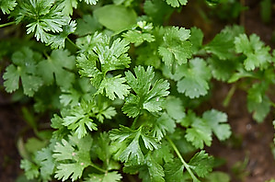Parsley is widely used throughout the world. It is native to the central and eastern Mediterranean. The herb is used in European, Middle Eastern and American cuisines. It is rich in iron and vitamins A and C. There are basically two varieties that are widely used, curly and flat. The flat leafed parsley tends to be more flavorful than the curly leafed parsley. However, curly leafed parsley can be used in a variety of dishes, especially as a fancy garnish. Growing parsley is quite easy both indoors and out. Read on to learn how to plant, grow, and harvest parsley. Also, gain an understanding of its nutritional values.
(Some of the links within this post are affiliate links on which I receive a small compensation from the sale of certain items.)
(As an Amazon Associate I earn from qualifying purchases.)
Growing Parsley – (family Apiaceae)
You can sow parsley seeds (Purchase parsley seeds from Seeds Now) both indoors and out. However, if you choose to transplant them, be very careful. They have a delicate tap root which can break off easily if not handled carefully.
Parsley is considered a biennial, but most use it as an annual plant. However, in temperate zones the parsley will naturally reseed. If used as a biennial, after its first year the leaves are usually bitter and tough.
Sowing Seeds
1. Soak your seeds in water overnight to boost germination. Not all seeds will germinate so you want to give them the best possible shot of becoming parsley plants.
2. When sowing indoors, plant seeds in individual pots 8 to 10 weeks before the last spring freeze in your area.

(Plant 3 to 4 weeks before last freeze date if you are sowing outdoors.)
3. The soil should be around 70 degrees F (21 degrees C).
How to Plant
1. Sow the seed 1/4 inch deep into well drained soil, rich in organic matter.
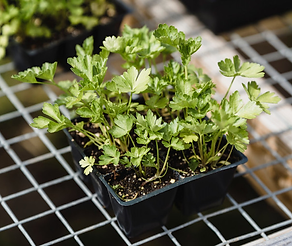
2. Plant the seeds 6 to 8 inches apart.
3. Place the pot in a south facing window which receives 6 to 8 hours of full sunlight.
4. Keep seeds moist while germinating.
5. Seedlings will appear in 2 to 4 weeks.
6. Use a grow light (Miracle LED Corded 4-Socket Grow Light Kit) to help the seedlings grow. The light should be at least 2 inches above the leaves.
7. You can either keep the seedlings in the pots or transplant them outside.
Transplanting Seedlings Outdoors
Select an area that receives full sun (at least 6 to 8 hours of direct sunlight).
Be sure the area you choose contains well-drained soil rich in organic matter. If it does not, amend it with good garden soil.
It’s best to plant them in a weed-free area so you can easily spot the sprouts in about 3 weeks.
Or you can purchase a mature parsley plant. Click here to purchase a parsley plant from Plants.com
Care for Parsley
For both indoor and outdoor parsley, keep the plants moist especially through the heat of the summer.
You can apply a light layer of mulch on top of the soil close to the base of the plant but not touching the plant. This will help conserve moisture in the soil.
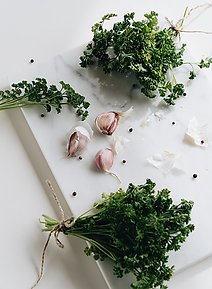
Harvesting and Storing Parsley
Harvest the parsley when you have at least 3 leaves on each stem. This will ensure the plant continues to grow.
Cut the leaves from the outer portion of the plant. Do not cut from the inner part of the plant. You want to allow it to grow and mature throughout the growing season.
Two Ways To Store Parsley
In the Freezer:
1. After harvesting the parsley, chop it into small pieces. Place the chopped parsley in a freezer bag and put it in the freezer.
OR:
2. Chop the harvested parsley and store it with a little water in ice cube trays. Place the trays in the freezer.
The parsley will last up to 6 months in the freezer.
Fresh Parsley:
Harvest the parsley at the bottom of the stems. Sprinkle the stems and leaves with a small amount of water and store them in a plastic bag in the refrigerator. Fresh parsley will last up to 2 weeks in the frig.
Drying Parsley:
- Cut the parsley at the base of the plant. Strip the bottom 2 inches of leaves and, rather than throwing those leaves out, store them choosing one of the methods above.
- Gather the remaining stems of parsley and tie them with twine.
- Hang them upside down in a well ventilated, shady and warm place.
- Once the parsley is completely dry, crumble the leaves and stems and store it in an airtight container.
The dried parsley will retain its flavor for up to one year in an airtight container.
Purchase dried parsley from Etsy.
Pests and Other Diseases/Troubleshooting
Parsley can acquire stem rot and leaf spots in its seedling stage. This is caused by fungi/ bacteria and/or parasites. Stem rot appears as gray, black, brown or vibrant red spots on the backs of the stems. Once the plant is infested with this, it is usually too late to ameliorate. Leaf spots present themselves as brown circular spots on plant leaves and can also be harmful to the plant. Therefore, you must be proactive and use measures to prevent this from happening.
Here are some steps you can take to keep your parsley and other plants healthy and thriving.
- Be sure to grow parsley in good draining soil. The fungi producing stem rot thrives in moist, poorly drained soil.
- Plant all the seedlings at the same depth (level with the soil) so they are not sitting in wet soil.
- Keep the soil away from the stem above the soil line.
- Provide good air circulation between your plants. When humidity is trapped between plants fungi will grow, especially in a warm climate.
- Don’t overwater or use pond or any other surface water that has accumulated outside. It may be contaminated with disease.
- If the plant doesn’t look too diseased, try repotting it in fresh, clean, and well-drained soil.
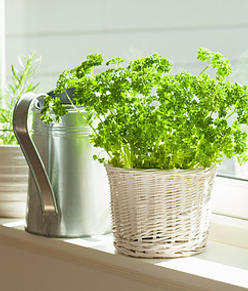
Medicinal Uses of Parsley
According to PubMed Central, a “highly respected database” as noted by the National Institutes of Health and cited on the website Healthline, parsley has many health benefits.
To begin with, parsley contains several nutrients that are essential for good health. A 1/2 cup of freshly chopped parsley contains:
- Calories: 11 calories
- Carbs: 2 grams
- Protein: 1 gram
- Fat: less than 1 gram
- Fiber: 1 gram
- Vitamin A: 108% of the Recommended Dietary Intake (RDI)
- Vitamin C: 53% of the RDI
- Vitamin K: 547% of the RDI
- Folate: 11% of the RDI
- Potassium: 4% of the RDI
In Addition, Some of its Benefits Include:
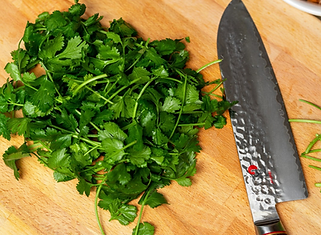
- Antibacterial properties. When studied in a test tube, parsley exhibited antibacterial properties that fight against yeast and mold. It also helped prevent the growth of harmful bacteria such as Salmonella and Listeria in foods.
- May reduce the risk of heart disease due to its richness in Vitamin B (folate which protects your heart).
- Protecting your eyes from such diseases as age-related macular degeneration (AMD). One half cup of chopped parsley contains 108% of the RDI of vitamin A. Vitamin A supports eye health.
- Antioxidants such as flavonoids and vitamin C which may protect against certain types of cancers. The antioxidants also prevent certain types of cell damage, thus lowering your risk of other diseases.
- An abundance of vitamin K which helps the body produce dense bones. Eating foods rich in vitamin K has been linked to a reduction of fractures and bone loss.
Growing Parsley – Final Thoughts
As you can see, it is quite simple to plant, grow, and care for parsley.
- Purchase seeds
- Soak the seeds overnight
- Plant them 1/4 inch deep in good, well draining soil
- Keep them moist
- Place them in a southern facing window to get at least 6 hours of full sunlight
- Once the seedlings have at least 3 leaves, transplant
Once you have your own healthy parsley plants, you’ll be able to incorporate it into many dishes and reap the benefits of all its natural medicinal benefits.
<====<Click Here for Herb Garden Complete Kit from Urban Leaf====>

I hope you enjoyed this post. Please share it with others and leave a comment below. I’d love to hear from you.
Happy Gardening!
Nina
bestgardeningforbeginners@gmail.com

